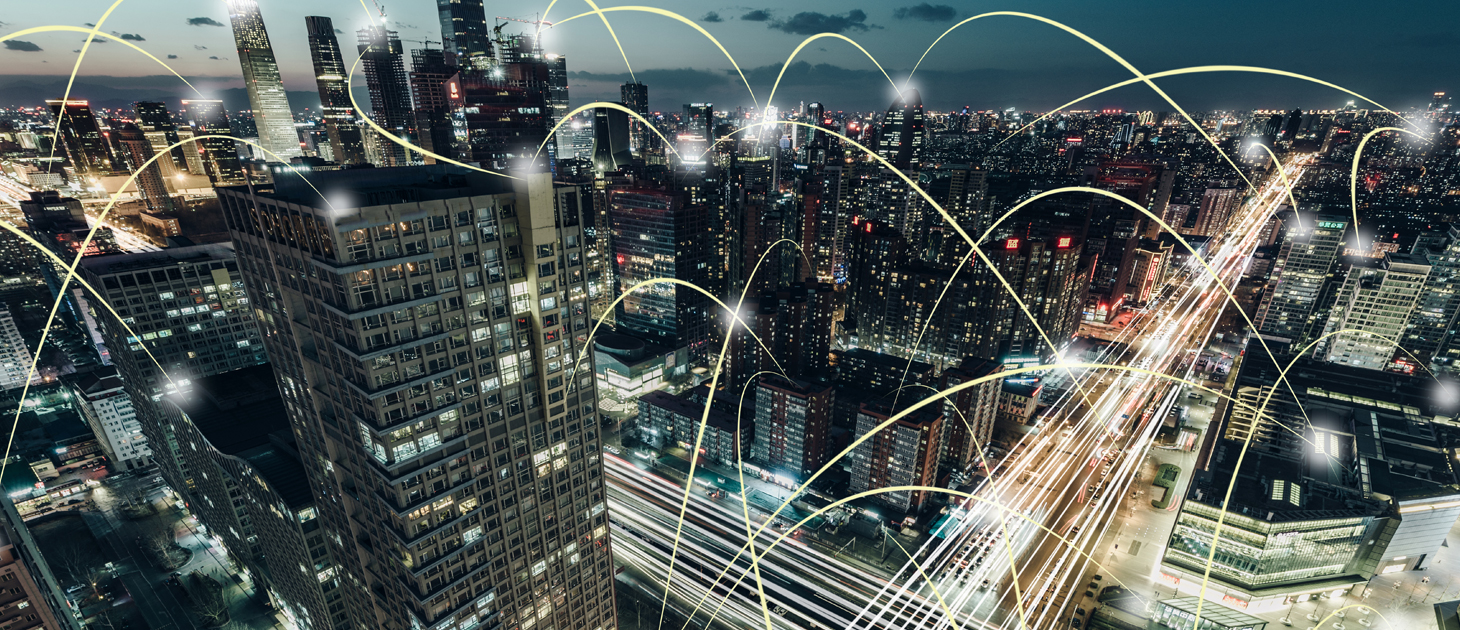A Tale of ‘Smart’ Cities
Smart city technologies can improve conditions for residents and middle-market businesses and create better systems and structures to support urban growth.

Today, over 54 percent of the world’s population resides in urban areas. By 2050, this number is estimated to rise to nearly 70 percent, with 1.4 million people added to the urban population every week. While this shift is poised to create immense opportunity for residents and middle-market businesses, it will also bring new considerations in urban planning. Taxed energy systems and overcrowded mass transit are only a couple of many issues that need to be addressed in the outdated infrastructure of urban areas today.
Thus, one of the most important opportunities for city planners is to create “smart” urban environments, or smart cities, that use technology to improve quality of life for residents and businesses and create better systems and structures to support urban growth. The proliferation of smart cities will transform the business community–it is important for governments, middle-market businesses and investors to work together to improve their city’s digital infrastructure and growth opportunities.
The smart cities market, composed of transportation, utilities, buildings and smart citizen services, is expected to reach $3.48 trillion by the year 2026, and middle-market companies will benefit tremendously. The digitization of cities will impact middle-market businesses across energy, housing, education, health care and more. The ultimate objective for a smart city, however, is for these industries to be interconnected under one centralized “brain” that allows them to work together. Smart cities will require intelligent infrastructure, public-private partnerships and accessibility for residents and businesses to succeed in today’s rapidly growing urban landscape.
‘Smart’ Infrastructure
Until recently, infrastructure referred solely to physical assets such as roads, streetlights and sewers. However, in the development of modern cities, it is important for middle-market businesses to consider smart infrastructure as the invisible data networks that connect, enhance and control physical fixtures. These include:
Smart cities will require intelligent infrastructure, public-private partnerships and accessibility for residents and businesses to succeed in today’s rapidly growing urban landscape.
- Smart Offices: Smart offices can leverage automation systems to monitor and control operations to improve lighting, air conditioning, air quality and employee security. This will not only allow employees to work more efficiently but will also provide valuable cost savings to middle-market businesses.
- Water Monitoring Systems: Underground water infrastructure can monitor and diagnose problems such as leaks and stoppages, take preemptive measures to manage maintenance and optimize water distribution.
- Connected Cars: Soon, self-driving cars will shuttle people in and out of the city so they can multitask with work or other activities. Smart parking meters can also inform drivers of parking availability.
With the advancement of the 5G network, a key smart city enabler, smart infrastructure will be supported by high-speed connection, quicker response times and increased data storage capacity.
The Power of Public-Private Partnership
Putting smart technologies to work in cities will require a new level of partnership among government, corporate and investor stakeholders. Middle-market businesses from a variety of sectors–such as construction, telecommunications and transportation–will play critical roles, as will relatively young industries such as artificial intelligence, clean tech, cybersecurity and renewable energy. As reported by Bank of America Merrill Lynch, here are examples of various global smart city initiatives driven by public-private partnerships:
- Singapore is undergoing one of the world’s largest smart city rollouts, Smart Nation, with a $2 billion program focused on large-scale data aggregation and transfer. This data network will be used by both government and middle-market businesses in the health care and banking industries to offer services such as predictive health care and cashless transactions to Singapore city residents.
- London, through partnership with FM Conway Ltd. and parking technology specialist Smart Parking Limited, deployed Infrared SmartEye sensors in more than 3,000 parking spaces to determine parking availability and transmit the information to the ParkRight mobile app to provide drivers with a real-time map of available spaces.
- Dallas Innovation Alliance (DIA), a private-public coalition including local government, corporations, civic organizations, NGOs and academia, joined forces to transform Dallas into a “forward-thinking, innovative smart global city.” DIA’s initiatives include the creation of a connected “living lab” and the installation of smart LED light bulbs in the city to capture real-time data on air quality and traffic congestion.
Accessibility and Personalization
To create a sustainable urban environment, city planners must ensure smart city technologies are accessible to residents and business owners. Smart city technology will enable everyday objects to become smarter and more connected, thus increasing the economic, social and environmental efficiency of the urban ecosystem. Through smartphones, TVs, tablets and wearable devices, residents must not only be aware of, but also comfortable with, the smart infrastructure around them. From individualized temperature and lighting controls, to customized retail experiences, no two lives in smart cities will be the same. Voice assistants, “smart” signage and responsive streets in smart cities will allow both community members and business owners to thrive in the urban ecosystem.
Smart cities have the potential to reduce the negative impact of urban population growth by using technology to cut energy usage, reduce traffic delays and stem water loss. By implementing smart technologies, business leaders and local governments in public-private partnerships can reshape urban environments and in turn, fuel economic growth. Investment in the modernization of cities, while crucial in facing short-term urban challenges, will also lay the groundwork for a more sustainable place to live, work and do business for future generations.

Robert Arth is northeast region head, global commercial banking, at Bank of America Merrill Lynch.
Bank of America Merrill Lynch is the marketing name for the global banking and global markets businesses of Bank of America Corporation. Lending, derivatives, and other commercial banking activities are performed globally by banking affiliates of Bank of America Corporation, including Bank of America, N.A., Member FDIC. Securities, strategic advisory, and other investment banking activities are performed globally by investment banking affiliates of Bank of America Corporation (“Investment Banking Affiliates”), including, in the United States, Merrill Lynch, Pierce, Fenner & Smith Incorporated and Merrill Lynch Professional Clearing Corp., both of which are registered broker-dealers and Members of SIPC, and, in other jurisdictions, by locally registered entities. Merrill Lynch, Pierce, Fenner & Smith Incorporated and Merrill Lynch Professional Clearing Corp. are registered as futures commission merchants with the CFTC and are members of the NFA. Investment products offered by Investment Banking Affiliates: Are Not FDIC Insured • May Lose Value • Are Not Bank Guaranteed.
©2018 Bank of America Corporation


